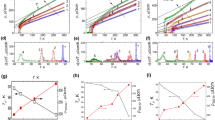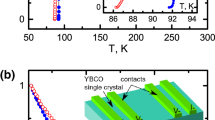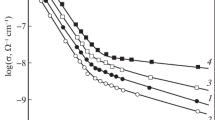Abstract
We review our work on irradiation effects in single crystal YBa2Cu3O7-x. Transmission electron microscopy has been employed to study the defect microstructures produced by irradiations with fast neutrons, MeV ions (Kr, Ne and p), and electrons. The atomic structure within defect cascades was investigated using 50 keV Kr and Xe ion irradiations to low doses. Evidence is shown for an amorphous structure with some incoherent recrystallization within individual cascades. Correlation with enhancements in critical current density produced by neutron irradiations suggest that this cascade structure effectively pins magnetic flux lines.
At sufficiently high fluences of fast neutrons or MeV Kr and Ne ions, a cellular microstructure is found. This structure consists of cells or microcrystallites of good crystalline and superconducting material (in the case of neutron irradiation), with cell walls of amorphous material. Full amorphization proceeds with the growth of cell wall volume. The formation of this microstructure coincides with a decrease in critical transport current, but is not observed by magnetization measurements.
Increases in critical current density under proton irradiation, comparable to those produced by neutron irradiation, have been reported. The defect structure produced by proton irradiations is examined here and found to differ from that of neutron irradiations. The structure is suggested to be consistent with the clustering of mobile defects (at 300 K) produced by the lower energy recoils which dominate in proton irradiations. In both the proton and fast neutron irradiations, to fluences producing the maximum enhancements in critical current densities, the degradations in critical temperature are not severe, <10 K.
Our most recent measurements of changes in critical temperature and current density, and defect microstructure following electron irradiations will be described
Similar content being viewed by others
References
A. R. Sweedler, C. L. Snead,.Jr., and D. E. Cox, in Metallurgy of Superconducting Materials, edited by T. Luhman and D. Dew-Hughes (Academic Press, New York, 1979), p. 349.
H. W. Weber, Kerntechnik 53, 189 (1989.
F. Seitz and J. S. Koehler, in Solid State Physics 2, edited by F. Seitz and D. Turnbull (Academic Press Inc., plNew York, 1956), p. 305.
J. P. Biersack and L. G. Haggmark, Nuclear Instruments and Methods, 174, 257 (1980).
L. R. Greenwood, in Reactor Dosimetry: Methods. Applications. and Standardization, edited by H. Farrar IV and E. P. Lippincott (ASTM STP 1001, Philadelphia, 1989), p. 598.
H. W. Weber, H. Böck, E. Unfried, and L. R. Greenwood, J. Nucl. Mater. 137, 236 (1986).
A. E. White, K. T. Short, D. C. Jacobson, J. M. Poate, R. C. Dynes, P. M. ankiewich, W. J. Skocpol, R. E. Howard, M. Anzlowar, K. W. Baldwin, A. J. F. Levi, J. R. Kwo, T. Hsieh, and M. Hong, Phys. Rev. B, 37, 3755 (1988).
G. J. Clark, A. D. Marwick, F. Legoues, R. B. Laibowitz, R. Koch and P. Madakson, Nuclear Instruments and Methods, B32, 405 (1988).
M. A. Kirk, M. C. Frischherz, J. Z. Liu, L. L. Funk, L. J. Thompson, E. A. Ryan, S. T. Ockers, and H. W. Weber, Physica C, 162-164, 532 (1989).
M. A. Kirk, M. C. Baker, J. Z. Liu, D. J. Lam and H. W. Weber, Mat. Res. Soc. Symp. Proc. 99, 209 (1988).
M. A. Kirk, M. C. Frischherz, J. Z. Liu, L. R. Greenwood, and H. W. Weber, Phil. Mag Lett., 62, 41 (1990).
W. Schindler, B. Roas, G. Saemann-lschenko, L. Schultz and H. Gerstenberg, Physica C 169, 117 (1990).
F. M. Sauerzopf, H. P. Wiesinger, W. Kritscha, H. W. Weber, G. W. Crabtree, and J. Z. Liu, to be published in Phys. Rev. B.
M. C. Frischherz, M. A. Kirk, J. Z. Liu, J. P. Zhang and H. W. Weber, to be published in the Proceedings of the ASTM Symposium on "Effects of Radiation on Materials", June 1990, Nashville, TN.
M. A. Kirk, M. C. Frischherz, J. P. Zhang, J. Z. Liu and H. W. Weber, to be published.
T. Diaz de la Rubia, R. S. Averback, and H. Hsieh, J. Mater. Res., 4, 579 (1989).
L. Civale, A. D. Marwick, M. W. McElfresh, T. K. Worthington, A. P. Malozemoff, F. H. Holtzberg, J. R. Thompson, and M. A. Kirk, Phys Rev. Lett., 65, 1164 (1990).
M. A. Kirk, G. Saxon and A. D. Marwick, to be published.
J. Giapintzakis, D. M. Ginsberg and M. A. Kirk, to be published.
M. A. Kirk, R. Wheeler and M.-O. Ruault, to be published.
Acknowledgement
It is a pleasure to thank many colleagues for their substantial assistance in this work. First, my appreciation goes to Prof. Harald Weber (Atominstitut, Vienna) for his initial encouragement and collaboration, especially in the heavy ion and neutron irradiation work, to Marcus Frischherz (Atominstitut and Argonne) for much of the TEM and computer work, to J. Z. Liu (Univ. California at Davis) for his wonderful single crystals, to Larry Greenwood (Battelle Pacific NW ) and John Farmer (University of Missouri) for assistance with the neutron irradiations, to Trixie Vlcek (Argonne), Kurt Vandervort (Univ. of Illinois and Argonne), and Ulrich Welp (Argonne)for very careful Tc and Jc measurements, to J. P. Zhang (Northwestern Univ.) for superb high resolution electron microscopy,to Alan Marwick, Leonardo Civale and other coworkers at IBM for their collaboration and interest in TEM measurements in the proton irradiation experiments, to Gerald Saxon (Thornton Highschool, Chicago) and Rebecca Brown (Univ. of Michigan) for assistance with in situ proton irradiations and TEM, to John Giapintzakis (Univ. of Illinois) and Don Ginsberg (Univ. of Illinois) for Tc and Jc measurements and collaboration in the electron irradiation experiments, and finally to Marie-Odile Ruault (CSNSM, Orsay) and Gustaav Van Tendeloo (Univ. of Antwerp) for collaborations in TEM work.
This work has been supported by the U.S. Department of Energy, Basic Energy Sciences-Materials Science under contract #W-31-109-Eng-38, by the National Science Foundation-Office of Science and Technology Centers under contract #STC-8809054, and by U.S. Department of Energy Superconductivity Pilot Center, Office of Utilities Technology, Conservation and Renewable Energy, under Contract #W-31-109-Eng-38.
Author information
Authors and Affiliations
Rights and permissions
About this article
Cite this article
Kirk, M.A. Irradiation Defect Structures In YBa2Cu3O7-xand their Correlation with Superconducting Properties. MRS Online Proceedings Library 209, 743–752 (1990). https://doi.org/10.1557/PROC-209-743
Published:
Issue Date:
DOI: https://doi.org/10.1557/PROC-209-743




